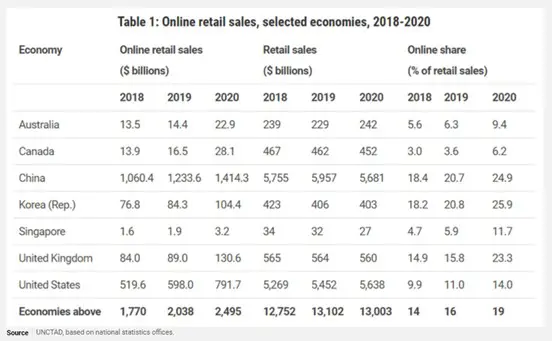How to choose an agile ecommerce platform that maximizes sales
The need for digital commerce is growing, and you’ll need an agile ecommerce platform for higher profitability. Consider these factors when choosing. Learn more below.

Whether you have a storefront or sell your items online through a third-party ecommerce site, you should set up your own ecommerce platform to reach your customers for more profitability. Even brick-and-mortar stores have an ecommerce site to create an online brand presence and sell to online shoppers.
Moving into online sales requires an agile ecommerce platform so you can stand out from the competition. This article will help you determine which ecommerce platform will work best for your organization and help you maximize sales with the highest functionality.
Online sales have historically increased at a 14% CAGR over the last four years. From 2019 to 2020, ecommerce sales saw an increase of 32% and are projected to continue rising.
Ecommerce solutions impact all aspects of your company’s value chain. Going digital is no longer an option. That said, take a moment to discover the best ecommerce platform for your organization to maximize its sales efforts.
Key takeaways:
-
Organizations must quickly pivot and place priorities on digital transactions and ecommerce websites in the growing competitive landscape.
-
Ecommerce is critical to retailers and business continuity. Without an agile ecommerce platform, your organization will not be able to pivot to meet customer demands.
-
Your organization must be able to scale both up and down according to consumer buying patterns and the current market to remain agile.
What makes an ecommerce platform agile?
Here are a few elements that make an ecommerce platform agile:
-
Ensures flexibility: An agile ecommerce platform is customizable and can be easily integrated into your existing infrastructure. Your technology and support need to adapt to your processes and workflows.
-
Facilitates productivity: The platform provides capabilities for cross-functional teams to work together to optimize workflows and simplify collaboration. Doing this will accelerate time to market.
-
Equipped to scale: An agile ecommerce platform will ensure that your organization can scale up and down according to the market demands by addressing customer buying patterns. That way, you can analyze, design and test before deploying product offerings.
Reasons to prioritize your digital commerce landscape
Succeeding with a digital transformation into the ecommerce marketplace is a prerequisite for long-term survival. The global ecommerce market jumped to $26.7 trillion since the dawn of the recent pandemic. Here are some more reasons you must prioritize moving into the ecommerce landscape:
-
Rising reliance on digital: COVID-19 has proven that companies need to be prepared to reach their customers on a platform that doesn’t include just face-to-face interactions.
-
Rising customer expectations: Consumers want their online shopping experience to have the same level of service that they have come to expect from brick-and-mortar companies. They want easy returns and on-demand resources for information.
-
Growing competitive landscape: If your organization doesn’t have an active digital presence, you can lose loyal customers to an organization better prepared to meet customer demands online.
-
Proving marketing ROI: Having ecommerce sales capabilities allows your organization to market more effectively to your customers. You can do this without costly advertising, giving you a better ROI on every marketing dollar spent.

Image source: https://news.un.org/en/story/2021/05/1091182
4 considerations when choosing an agile ecommerce platform
Here are some questions to ask yourself when choosing an agile ecommerce platform for your organization:
1. What type of ecommerce platform does your organization require?
When selecting a solution, always ensure that it is secure. Cloud-based platforms are convenient because they can eliminate the costs and hassles of maintaining your own hardware. However, on-premise platforms provide a level of security that cloud-based options do not.
To determine which option is best for you, consider the many types and what each offers. The different types of ecommerce platforms include:
- Traditional ecommerce platform: You pay to license the software, and then your DevOps or IT department builds and customizes the platform.
- Build your own ecommerce platform: Your DevOps team develops the site, or you contract a web developer to design the site for you.
- SaaS ecommerce platform: Your site runs on a single codebase platform where everyone has the same technology for a monthly service fee that includes server space, security, maintenance and upgrades.
- Open-source ecommerce platform: These sites are like traditional platforms, except there are no upfront costs of purchasing a license. Although, the costs associated with this platform include the initial development, migration and upgrades.
Often, open-source and traditional platforms run on a cloud-based server base. However, developers can also program these sites to run from on-prem servers. A SaaS platform does not operate on-prem or as a cloud-based service.
2. Do you know the most cost-effective option to meet your organization’s needs?
Different ecommerce sites will have various price points based on what you are looking for in a platform. If you build your own, you'll have complete control over every aspect. However, this also comes at an expense.
An ecommerce platform will manage:
-
Checkout
-
Payments
-
Hosting
-
Analytics
-
Fraud protection
-
PCI compliance
These are just some of the basic services covered with your service plan. Additional services will be available with different pricing models.
Therefore, when selecting your ecommerce platform, make sure you know what you are paying for with your plan. From content management system (CMS) integration to payment processing, make sure the services you need are available at the price point you are willing to pay.
3. Does your ecommerce stack focus on the customer experience?
An agile ecommerce platform enables you to respond to customer needs promptly and regularly. You can cultivate loyal customers and keep in touch with your buyers to gain their repeat business. Repeat customers spend 67% more on the subsequent orders.
Your ecommerce stack should help you provide data-driven recommendations to your current customers. Drive more revenue by enhancing customer experience to match the right visitor segments with the right digital experience.
Also, you will want to ensure that your ecommerce platform provides customers with location-specific offers for increased user engagement.
4. Is your organization capable of selling to mobile shoppers?
In 2020, 45% of all U.S. ecommerce sales happened on mobile devices – amounting to an estimated $284 billion in revenue for that year alone.
Choosing the best ecommerce platform requires that you create a mobile shopping interface that makes it easier to shop online no matter what device your customer is using. You will want to guarantee your ecommerce platform:
-
Scales naturally to various screen sizes
-
Offers push notifications
-
Has a simple checkout process
-
Contains auto-fill forms
-
Provides single-click payments options
How Optimizely can help with data-driven decision making in ecommerce
At Optimizely, we provide an all-inclusive platform for experimentation, data analysis, and decision making to help you take your organization to unlock its full ecommerce potential.
